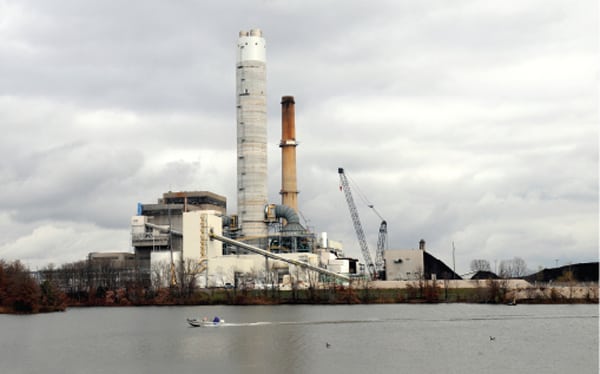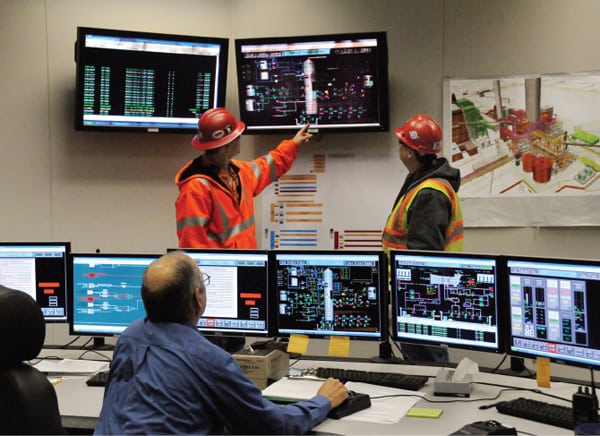Top Plant: Coffeen Energy Center, Montgomery County, Illinois
Owner/operator: Ameren Energy Resources
Situated in predominantly rural central Illinois, the 1,000-MW Coffeen Energy Center has installed a number of controls in recent years and achieved significant environmental performance. For example, in 2010 a new scrubber facility was added that reduces SO2 from combustion gases coming from the plant’s two coal-fired boilers. The plant personnel’s continuing commitment to protecting the environment helps to promote a strong relationship between the plant and the local community.
 |
| Courtesy: Ameren Energy Resources |
Bordered on the east by the historic Route 66 Highway, Montgomery County, Ill., includes large tracts of fertile croplands and protected natural areas. Management and staff at the coal-fired Coffeen Energy Center work hard to control air emissions and take other proactive steps to protect the natural resources of the area. Recently, Ameren Energy Resources (AER) invested in new energy center equipment and control systems that have improved operation and reliability at the Coffeen plant and helped to make it one of the cleanest coal-fired plants in the nation.
“Coffeen is located in Montgomery County, which is mostly rural, with small towns and limited business base,” Jeff Coyle, plant manager told POWER in August. “The plant provides jobs and a tax base to the local community, and we work hard to be a good corporate neighbor.”
As one example of the facility’s efforts, Coyle explained that “Coffeen Lake is owned by Ameren, but Ameren has a lease agreement with the Illinois Department of Natural Resources to manage it, and the lake is considered a wonderful year-round hunting and fishing resource.”
Visitors to Coffeen Lake can find a diverse range of wildlife. Muskrats, turtles, herons, and mussels can be seen in or near the water. Bobwhites, coyotes, white-tailed deer, black rat snakes, red-tailed hawks, and blue jays are also common to the area.
Plant Upgrades
In February, the plant began a major outage that involved replacing all 14 of the 1970s-era cyclones in the Unit 2 boiler and several other plant improvements. The plant returned to service in May.
Coffeen’s Unit 1 came online in 1965. The original engineering firm was Sargent & Lundy, and Alberici was the original construction company. Unit 2 went commercial in 1972 with the same engineering and construction partners.
New environmental control systems have been installed on both units during the past decade—bringing to more than $1 billion the investment made in environmental controls at this site alone. (Additionally, in the past few years, AER has spent more than $1 billion on environmental improvements on scrubbers, precipitators, new landfills, and mercury reduction technologies at its other power plants.) In 2009 and 2010, scrubbers were installed on Coffeen Units 1 and 2. These sophisticated systems help to significantly cut the plant’s sulfur dioxide (SO2) emissions and also reduce mercury emissions. Reducing SO2 emissions by more than 90%, the scrubbers are designed to redirect the outlet stack gas through a spray-tower scrubber design, where the gas mixes with water, a 20% limestone mixture, and compressed air. The SO2 in the flue gas then reacts with the limestone to produce a gypsum by-product that can either be sold for commercial use or placed into a landfill for disposal.
In addition to scrubbers, other recent environmental improvements at Coffeen included an electrostatic precipitator (ESP) upgrade on Unit 1 and a new ESP on Unit 2. Though ESPs have been around for many years, the ones installed at Coffeen offer the latest improvements that make them very effective in ash removal. Recent environmental projects also have included installation of new selective catalytic reduction (SCR) systems on both units and the addition of other environmental control equipment and systems that support cleaner water and air.
Alberici, the construction company in charge of the project, handled the mechanical installation of two large, state-of-the-art absorber vessels and related equipment supplied by Hitachi Power Systems America Ltd., while Sachs Electric of St. Louis did the electrical portion of the work. Alberici worked with Ameren’s engineering firm, Sargent & Lundy, to deliver this project on an aggressive schedule driven by the need to meet regulatory commitments while adapting to the economic downturn.
One of the major construction challenges is the configuration of Lake Coffeen in relation to the plant, according to Coyle. The 1,100-acre lake was created in the early 1960s by building a dam to capture the flow from the McDavid Creek. The resulting lake is horseshoe-shaped with the plant sitting in the middle. The area available for environmental equipment additions is very limited.
“It took a lot of effort to design and construct the interface tying the plant to air, water, and electrical systems in this small space,” he said. “Building the new equipment very close to the operating plant and maintaining operations was also a challenge. Additionally, the new scrubbers require as much as two million gallons of water per day and a state-of-the-art pumping station was installed in a nearby creek to capture additional water from a larger watershed area to support operation.”
The plant’s recent large construction projects at their peak meant jobs for up to 800 craftspersons along with numerous engineers and other professionals and added large amounts of money to the local economy. Coyle said, “We continue to infuse significant dollars into the local economy each year through contracted work and services.”
Facility Overview
Coyle summed up Coffeen’s efficiency rate by pointing out that “we expect to produce more than 7 million MWh net per year.” The heat rate of Unit 1 is approximately 10,200 Btu/kWh; Unit 2 is about 9,800 Btu/kWh.
The facility has upgraded its rotors over the past decade, with the most recent improvement being a Toshiba high- and intermediate-pressure turbine installed in Unit 2 in 2010. “High-efficiency turbines have been installed in both units, which have allowed us to increase generation output for the same coal use,” Coyle said. “This has the benefit of offsetting the increased auxiliary load required by the new scrubbers by implementing energy efficient projects.”
The expectation is that future equivalent availability will be >90% and the capacity factor will be nearly the same level to take advantage of the units’ low-cost, low-emission capability, Coyle explained.
The plant is operated and maintained by 170 full-time employees (Figure 1). There is a strong emphasis on plant safety, which has dramatically reduced accidents in recent years. Coyle pointed out that the plant had zero accidents through the first half of 2011.
 |
| 1. Keeping things under control. In the control room at Ameren Energy Resources’ Coffeen Plant, in central Illinois, operations and engineering personnel discuss the operating parameters of one of the newly installed scrubbers. Courtesy: Ameren Energy Resources |
Striving for Ongoing Environmental Excellence
As part of the recent environmental improvements, the plant added new certified fly ash and gypsum landfills that are used to store by-products from burning coal. Coyle explained that 100% of the bottom ash is reclaimed and beneficially used in post-combustion aggregate products.
Coyle emphasized that the Coffeen plant is one of the cleanest fossil plants in the nation in terms of regulated emissions. He gave credit for the “very effective” contaminant control to a recent investment in equipment for both units, including overfire air systems for NOx control, SCR, ESP, and wet scrubber technologies.
“Multiple federal and state environmental regulations have been added since the plant first came online,” Coyle said. “We presently operate within stringent Illinois Multi-Pollutant Strategy requirements and are well-positioned to meet the new Cross State Air Pollution Rule.”
— Angela Neville, JD, is POWER’s senior editor.